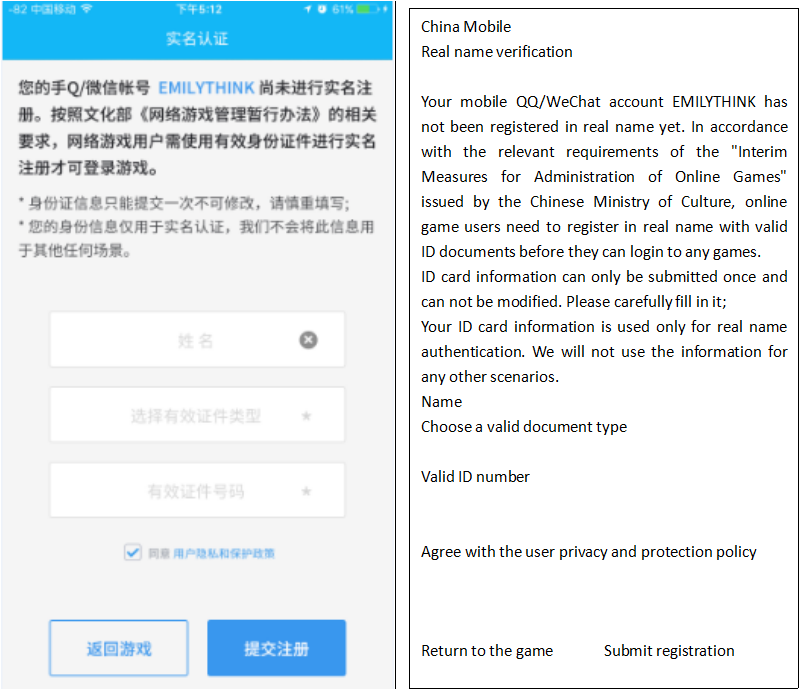Outline
In accordance with the relevant provisions of "Interim Measures for Management of Online Games" issued by the Chinese Ministry of Culture, online game users need to use a valid identity document to make real name registration before they can login any game. In order to reduce the burden of game developers, we have customized the real-name authentication UI and the entire interfaces for games. Through the module, you only need to spend a few minutes to complete the real-name authentication function:
1 Mode 1 (MSDK custom UI):
Use our custom UI to complete the real-name authentication

Because the real-name registration process can interrupt the login process, if the game needs to handle the timeout in the msdk login, please stop handling msdk login timeout when receiving eFlag_Need_Realname_Auth flag in the login callback OnLoginNotify.
Access Guide
1 Preconditions
If you use the real-name system function, you must first access msdk2.14.2 and higher versions
2 Access configuration
Note: this configuration only supports the previous version of MSDK 3.2.14i. Starting from version 3.2.14i, the real name is connected to the central control, which is processed by the central control side. Central control details consulting interface person: cc_helper
1)Mode 1(MSDK custom UI):
- Import MSDKResources.bundle. Otherwise, the real-name authentication page’s button image will be missing.
- In the project's info.plist, add MSDK_REAL_NAME_AUTH_SWITCH NSNumber type of switch, whose values are: 0 and 1. In the event of no configuration, the defaulted value is 0. The configuration example is as follows:

Note: The difference between MSDK_REAL_NAME_AUTH_SWITCH=0 or =1
If MSDK_REAL_NAME_AUTH_SWITCH=0, eFlag_Need_Realname_Auth as the value of flag will be received in the login callback OnLoginNotify at the time of login authorization. When the game receives this flag, the user only needs to cancel the login timeout protection and stay on the login page (don’t call Logout interface). At this time, MSDK will automatically pop up the real-name registration UI to guide the user to complete real-name registration. No matter whether the user's real-name registration succeeds or fails, there is no callback. The user needs to return to the game’s login page and click the login button again, and the game shall continue listening to the login callback.
If MSDK_REAL_NAME_AUTH_SWITCH=1, eFlag_Need_Realname_Auth as the value of flag will be received in the login callback OnLoginNotify at the time of login authorization. When the game receives this flag, the user only needs to cancel the login timeout protection and stay on the login page (don’t call Logout interface). At this time, MSDK will automatically pop up the real-name registration UI to guide the user to complete real-name registration. If the user's real-name registration succeeds, msdk's automatic login interface will be automatically called and the game's automatic login results will be called back. If the login succeeds, OnLoginNotify will call “Login succeeds” back to the game. If the login fails or the user's real-name registration fails, OnLoginNotify will call “Login fails” back to the game.
3 Workflow of the real-name system

real name authentication
Mode 1(MSDK custom UI):
If the game selects Mode 1, it only needs to complete Mode 1 configuration according to Access Guide-> Access Configuration.
FAQ
1.In case that no real-name authentication UI pops up, please use tools to query whether the real-name authentication has been done.
Real-name query tool:
Verify real name via QQ: login via PC or mobile phone http://jkyx.qq.com/
Verify real name via WeChat: login via mobile phone http://nginx.msdk.qq.com/wxrealname
2.Check whether the current environment is the test & joint debugging environment (need to be in the test & joint debugging environment).
The real-name system of the test joint environment is completely open. The formal environment is totally closed before October 1, 2016. For games which need to be tested in the formal environment before the date, please contact us to apply for early opening.
3.A real-name authenticated ID card can now bind 50 numbers at most

